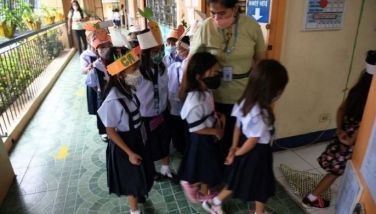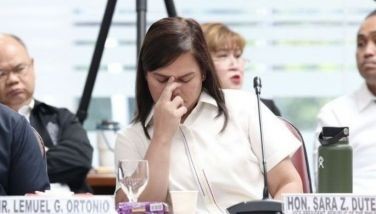After Milenyo, it’s Ompong, Paeng
October 4, 2006 | 12:00am
 Exit "Milenyo." Enter "Neneng." And soon, "Ompong."
Exit "Milenyo." Enter "Neneng." And soon, "Ompong."
And for the rest of the year the typhoons that will visit the country will be called Paeng, Quadro, Rapido, Sibasib, Tagbanwa, Unman, Venus, Wisik, Yayang and Zeny.
If the number of cyclones that will come within the Philippine Area of Responsibility (PAR) this year exceeds the Philippine alphabet, there is an auxiliary list of names for the atmospheric disturbances: Agila, Bagwis, Ciriaco, Diego, Elena, Forte, Gunding, Hunyango, Itoy and Joanna.
The rationale behind the auxiliary list is that there was a year — 1964 — when more than 30 typhoons hit the country.
Yes, the names of typhoons to pass the Philippines until 2016 are in place.
The list of names had been prepared as early as 2000, or a year after the "Name a Bagyo Contest" launched by the Philippine Atmospheric, Geophysical, and Astronomical Service Administration (PAGASA), which is under the Department of Science and Technology (DOST).
In the contest, about 18,000 entries were submitted by participants, 140of which were selected and assigned to the cyclones that would cross the Philippines from 2000 to 2016.
As decided, the names of typhoons assigned in a given year will be the same for those that will visit the country every four years thereafter.
For instance, the names of the typhoons to cross the country this year will be the same as those to be given in 2010 and 2014.
Milenyo, one of the strongest and deadliest ever to lash the country in over a decade, had been preceded by Agaton, Baayang, Caloy, Dagul, Espada, Florita, Gloria, Hambalos, India, Juan, Kaka and Lagalag.
Expect the typhoons next year to be named Amang, Batibot, Chedeng, Dedong, Egay, Falcon, Gilas, Harurot, Ineng, Juaning, Kabayan, Lakay, Manang, Nina, Onyok, Pogi, Quiel, Reskas, Sikat, Tisoy, Ursula, Viring, Wang-Wang, Yoyoy and Zigsag.
The auxiliary list for 2007 has Abe, Berto, Charing, Danggit, Estoy, Puego, Gening, Hantik, Irog and Joker.
Interestingly, in the 1999 nationwide search for new generation tropical cyclone names, no gender-biased local names were noted from the participants, according to DOST’s Vicky Bartilet and Cheryl Berin and PAGASA.
Historical records show that cyclones used to be named after women, a practice started by Australian weatherman C. Wragge before the end of the 19th century. Before 1890, the world’s tropical cyclones were randomly named.
Naming of storms became so popular that air force and navy forecasters gave their wives and girlfriends the distinction of having storms named after them.
In 1942, the United States press named a storm after President Truman and named another one after his wife Bess.
However, the Bartilet-Berin-PAGASA report noted, a rare occurrence happened in 1946 when three storms developed simultaneously in the western North-Pacific basin where the Philippine territory is located.
"Instead of names, all three were identified based on location," it stated. "This caused confusion because the public could not identify which storm was being reported. Early the next year after that rare case, weather forecasters decided to identify storms using names in alphabetical order."
In 1963, the Philippine Weather Bureau adopted the system of setting four groups of Filipino women’s nicknames ending in "ng" from A to Y to name all tropical cyclones occurring within the Philippine Area of Responsibility.
These four sets of names were then repeated every four years.
However, each group was accompanied by an auxiliary list from A to G in the event that the number of typhoons occurring in a particular year exceeds the number of Filipino alphabet letters.
The 1999 "Name a Bagyo Contest" further systematized the naming of typhoons in the country.
"Our ultimate aim of issuing local names," a PAGASA report says, "is to inform national and local disaster coordinating council and the public of the presence of such cyclones and immediately enable them to implement their disaster preparedness plan and undertake necessary precautionary actions."
The names now being used are the citizens’ choice since most of these came from those who joined the "Name a Bagyo Contest," it adds.
BrandSpace Articles
<
>
- Latest
Latest
Latest
November 30, 2024 - 5:19pm
By Joanna Perfecto | November 30, 2024 - 5:19pm
November 23, 2024 - 6:23pm
By Rupert Paul Manhit | November 23, 2024 - 6:23pm
November 23, 2024 - 1:52pm
By Edilberto de Jesus | November 23, 2024 - 1:52pm
November 14, 2024 - 7:00am
By Cielo Magno | November 14, 2024 - 7:00am
November 9, 2024 - 3:31pm
By Rupert Paul Manhit | November 9, 2024 - 3:31pm
November 2, 2024 - 5:36pm
By Venice Isabelle Rañosa | November 2, 2024 - 5:36pm
Recommended


























